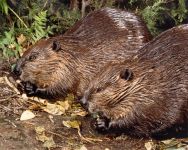


|

|
|
 
|
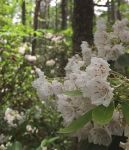
Summer at the Refuge
Things are warming up at the Refuge! It is summer and there is activity everywhere. There are many bird nests in the trees – those of migrating birds who are here just for the season as well as those of birds whose home is the Refuge all year. The main pond is alive with beavers and deer feasting on the water lilies. Ospreys, eagles, herons and even an occasional cormorant fly over and perch near the water's edge. A large variety of amphibians, reptiles, arachnids, insects and other animals can be seen throughout the diverse habitat. The place is rich with numerous plants and the woods are lush with flowering mountain laurel (pictured) and ripening berries.
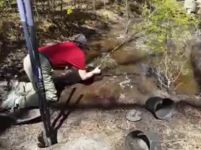
Teaming up for local conservation
We recently joined up with volunteers from the Piney Hollow Preservation Area to help them install extra trail protections to prevent off-road vehicle use and then helped plant dozens of white cedar saplings (see photo captured from video) in an area previously heavily damaged by these vehicles. The Piney Hollow Preservation Area is the newest addition to the Franklin Township Parks Service and comprises 222 acres bordering part of the Refuge along Unexpected Road.
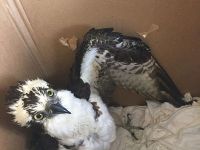
Injured osprey rescue and transport
In May, we received a call for help from a local wildlife rehabber regarding the rescue of a young osprey who had been spotted in Linwood, New Jersey. The bird had a fish hook through one foot and was hanging, upside-down, by the attached fishing line wrapped around a large bough of a tall tree. Volunteers were able to reach and free the bird. We provided the transportation to get her to Tri-State Bird Rescue & Research in Delaware – the most qualified clinic for osprey rehab and release. Just prior to preparing this newsletter, we learned that she died despite apparently doing well for many days. This is, unfortunately, not an uncommon end for wild animals who are injured and brought in for rehabilitation. We should not, however, discontinue trying to help these animals, especially when members of our species are the cause of their problems; we do have success.
Fishing lures, hooks and lines are a danger – often fatal – to all wildlife. As you might guess, we think they should be banned – along with the unconscionably cruel practice of fishing.

Home for migratory nesting birds
The Refuge atmosphere has been sweet with the melodious song of the Baltimore oriole, a bird who migrates to the Refuge to nest in the spring. Here, a colorful male perches, mid-song, in a tree at the Refuge.
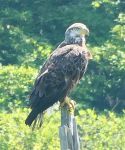
Juvenile bald eagle a frequent sight
We have been seeing this juvenile bald eagle almost daily, perched in one of two favorite spots near and on the main pond. Although he was too far away to photograph with our previous camera, our new camera courtesy Lush's Charity Pot giving program made it possible to get a reasonable image. Here you can see what appears to be a bright yellow water lily flower stuck on one talon. We were concerned at first that it might be a latex balloon wrapped around his leg. It turned out not to be the case as he quickly shook it off before taking flight into the tall pines across the pond.
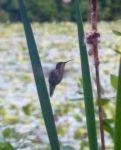
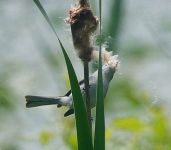
Birds visit the local cattails for nesting material
Nesting birds have found one of their favorite materials in the cattails near the main pond. Once the cattails go to seed, they provide fluffy material that makes for a soft and warm lining in nests of various types. Shown are photos of a blue-gray gnatcatcher and a female ruby-throated hummingbird delicately plucking the 'fluff' from a cattail.
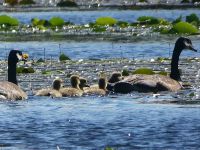
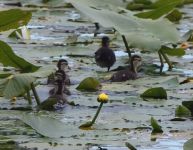
Time for babies
When their babies are small, wood ducks and Canada geese normally keep them well-hidden from view. We were thrilled, therefore, to see two sets of these normally elusive parents, hustling their youngsters across the pond. It was particularly endearing watching one of the wood duck babies carefully picking her way from lily pad to lily pad instead of swimming with her siblings.
Many phone calls about 'orphaned' baby animals
As often happens this time of year, we have been receiving phone calls from numerous people concerned about 'orphaned' wildlife. In almost all cases, however, the youngsters are not orphaned! Instead, they have been left alone temporarily while the parents are out looking for food. Unless the babies are injured, lethargic or near a dead adult, they should not be approached or otherwise disturbed. Barring imminent, non-natural threats, it is almost always best to leave baby animals where you find them. Fledgling birds in particular may appear in distress, but it is common for young birds to leave the nest before they can fly and their fluttering about on the ground is part of the normal process of preparing them for flight.
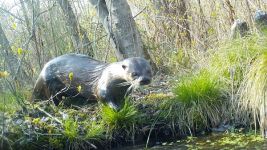
River otters at the Refuge
I have been trying for more than a year to get a photograph of one of the otters at the Refuge. Because of the otters' generally elusive nature, I set trail cameras at various sites. While scrolling through hundreds of images recently, I found that I was in luck, as one of them was this great photo of this otter at water's edge.
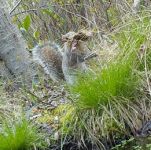
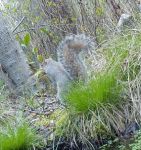
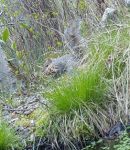
Squirrel gathering nesting materials
The birds are not the only ones at the Refuge gathering premium nesting materials for the arrival of their babies. We recently spotted this gray squirrel in trail-camera images, making frequent trips to the ground for grasses and soft leaves. You may recognize the site as being one and the same for the previously mentioned otter.
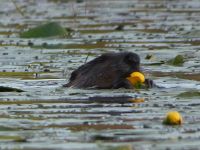

Lily pads, a spring delicacy
The white-tailed deer and beavers have been making a frequent meal of the readily available water lily greens and flowers in the main pond. It is not unusual to see the deer 'chest deep' in the water as they browse for this abundant source of nourishment.


Prothonotary warbler 'visits' our headquarters
I have been repeatedly thwarted in my efforts to photograph the prothonotary warblers at the Refuge. These brightly feathered birds with their fascinating voices have been nearly impossible to 'capture' with my camera. Recently, one flew into the porch and did not seem to know how to escape. Normally, birds in these situations will become greatly distressed if a person approaches them in an attempt to release them. This individual, however, seemed placid so I slowly and carefully reached out my hand and, to my surprise, he hopped right up and onto it. He stayed there as I slowly walked to the door and then he flew out – not, I am glad to say, before I was able to get these photographs.

Slow down – amphibians and turtles crossing!
If you are planning to visit the Refuge this summer, please be careful when driving down the lane. We have been seeing numerous frogs, toads and turtles crossing the driveway. Also, when preparing to leave, check underneath your car to be sure that someone is not using it for shade. This is particularly the case with some of the turtles.

Boardwalk improvements
We were fortunate to recently be approved for a small grant through the Lush's Charity Pot giving program. One of the projects that received funding was the refurbishment of some of the historic, broken boardwalks at the Refuge. We are now seeking the permit necessary to start the work. Once this has been secured, we will begin the project, using environmentally friendly, untreated red cedar wood for repair and replacement. If you have 'carpentry' skills and would like to help, please let us know.

Continuing reminder about helping us help wildlife today
This Refuge and its nearly 800 acres of rigorously protected habitat, is home and sanctuary for hundreds of animal and plant species; many of the animal species have been here for generations. We depend entirely on the support of our donors for our day-to-day expenses! The Refuge – and the wildlife living here – could not exist without you. We know that you have limited resources and need to consider which of numerous worthwhile causes to support. We hope, however, that you can again find it possible to give us a donation – today – of any amount. We need your support right now. Our small operating costs continue to exceed our donations.
Helping wildlife and the Refuge in the future
We remind you to please remember Unexpected Wildlife Refuge when planning your will and estate. It is an easy, effective and lasting way to help the Refuge... and wildlife. When talking with your estate planner, just provide them with our name, address and tax identification number (23-7025010). This is one of the most important gifts the Refuge can receive. If you have already included us in your future plans, thank you!
Our newsletters are the result of a team effort involving people dedicated to protecting wildlife in general and furthering the Refuge in particular:
Unexpected Wildlife Refuge
Mailing address: P.O. Box 765, Newfield, NJ 08344-0765
Web site: http://unexpectedwildliferefuge.org/
E-mail: manager@unexpectedwildliferefuge.org
Telephone: 856.697.3541
Facebook: https://www.facebook.com/UnexpectedWildlifeRefuge
Instagram: https://www.instagram.com/Unexpected_Wildlife_Refuge/

